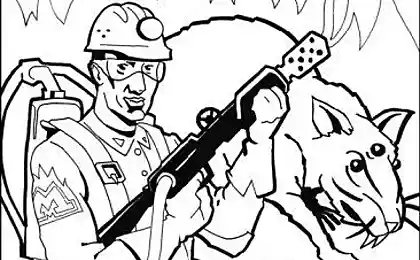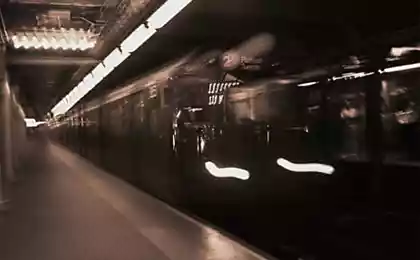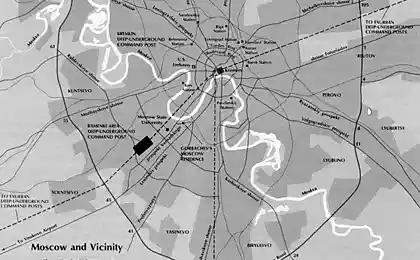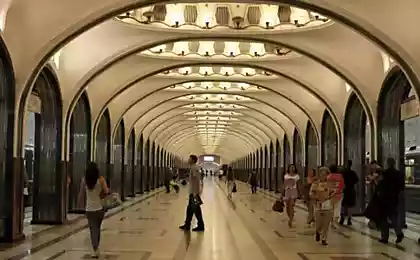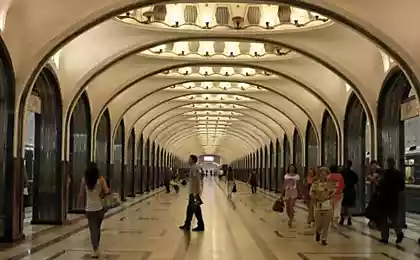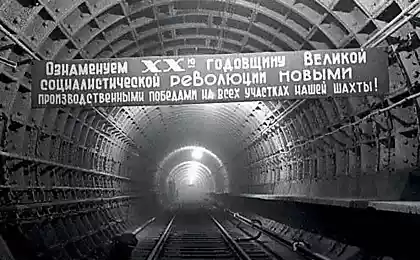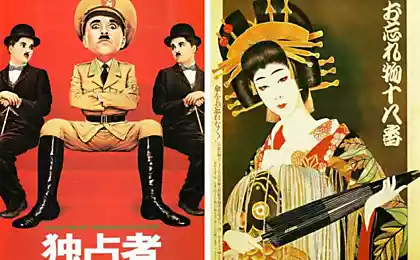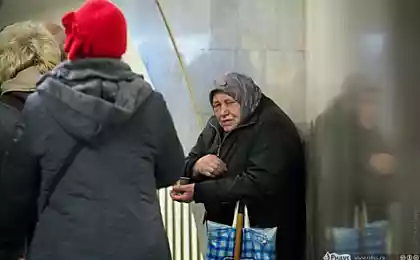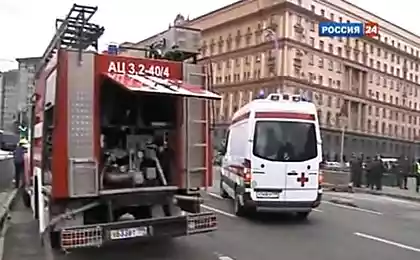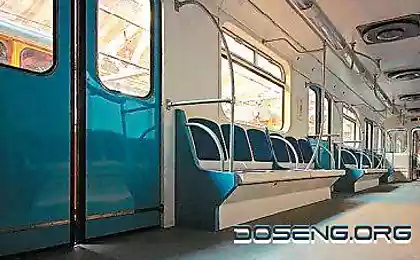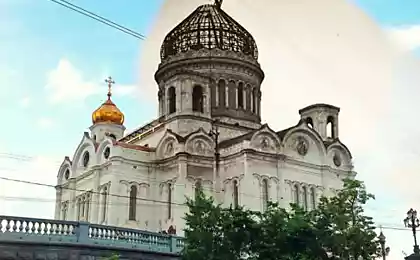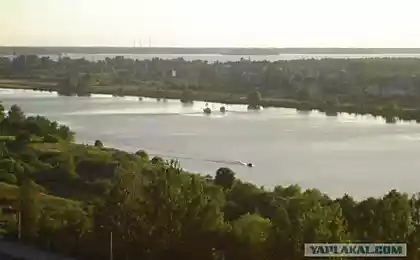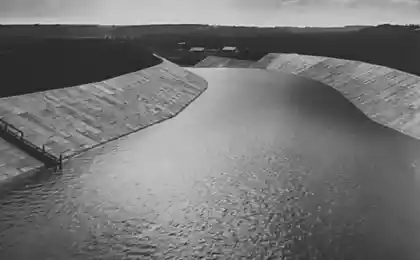1584
Secret Moscow Metro
Dear friends! Let me suggest a topic.
Someone knows about it, so probably all heard.
I will try once again to their interpretation.
Material from many sources + own knowledge, so no links.
So: Since the beginning of the 90s, there were rumors about the existence of secret subway. Allegedly, three or four branches leading from the Kremlin to the military installations in Moscow (Podolsk Chekhov Vnukovo-2). When the Americans dropped the atomic bomb on Moscow, the government will be able to evacuate to a safe place.
According to some sources, this system is called
Metro-2, on the other - D-6.
20 ph and many letters

Location of sensitive sites in Moscow - a state secret. Until now, for example, footage of the annual aerial surveys of the capital in sealed packets sent to preview the headquarters of the Moscow Military District, and their storage is carried out subject to the expanded list of information to be classified according to the system of the Federal Service for Geodesy and Cartography of Russia.
This card is made of sensitive sites on the basis of public documents of the Moscow authorities, and therefore can not be complete. But even in this truncated form clearly shows the enormous area in the city center occupied by the security services.
On the map we have noted only unclassified intelligence services facilities - the headquarters, hospitals, hotels, etc. But there is among them a special list - the so-called "objects of subway construction Transinzhstroy," the former management of 10-A. The map clearly shows that not all of these objects are the same as the conventional scheme of the Moscow subway ...
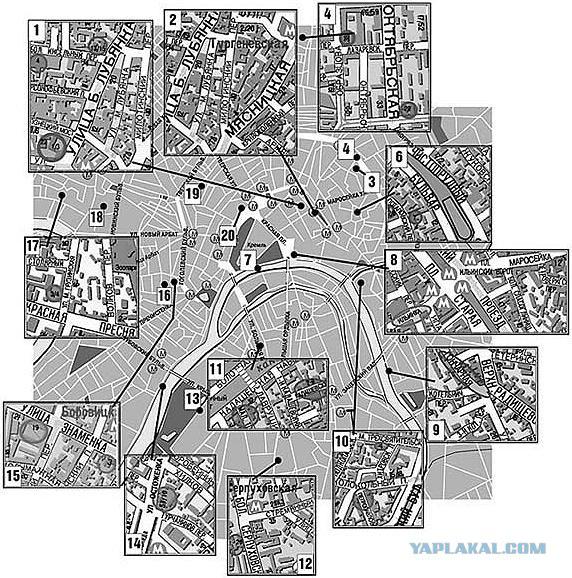
1. FSB - st. B. Lubyanka, 1/2, Reception FSB - Kuznetsky Most, 22, Ch. the building of the Moscow department of the FSB - B.Kiselny lane. d.13 / 15
2. The object of subway "Transinzhstroya" - Krivokolenny lane.
3. Object FAPSI - Myasnitskaya Str. D. 48, p.1.
4. The building FAPSI - Sakharov avenue
5. Department of the Moscow department of the FSB in the North-East SA - ul. October 28, MOPNIEI and STC "Atlas" FAPSI - st. Obraztsova, 38,
6. Dep. Moscow Department of the Federal Security Service Center. And South East SA - Potapov lane. 7 subway construction object "Transinzhstroya" - Potapov lane. ow. 2/8
7. FSO GUSP - Kremlin
8. The Security Council and the CIS Antiterrorist Center - Str. Ilinka, FTPS - Maroseyka 12
9. The object of subway "Transinzhstroya" - st. Pottery, ow. 22-25
10. The object of subway "Transinzhstroya" - between Podkolokolny and Paul Lane., Clinic FSB - Trehsvyatitelsky M. per., 4, page 2
11. The object of subway "Transinzhstroya" - 2nd Kadashevsky lane. Tolmachevsky per., 5-7
12. The object of subway "Transinzhstroya" - st. B.Serpuhovskaya ow. 26
13. The object of subway "Transinzhstroya" - Maronovsky lane.
14. Press service of the Foreign Intelligence Service - st. Ostozhenka 51/10.
15. Object FAPSI (referred Shilov Gallery) - st. Znamenka, 3 p.1., State Technical Commission - st. Znamenka, 19.
16. Ministry of Defence - a complex of buildings on the Arbat
17. NTC "Atlas" FAPSI - st. M.Gruzinskaya, 3, p.4
18. The object of subway "Transinzhstroya" - Barrikadnaya, 8
19. Hotel FSB - the hotel "Beijing", 5th floor
20. The object of subway "Transinzhstroya" - Dmitrovsky per., 5-7
Metro-2 - the total informal name of the existing network of secret underground communications for special purposes in Moscow.
Official information about the network location of its lines and stations available. The Russian government officially neither confirm nor deny its existence. Also, there are no published pictures, videos, and any other evidence of the existence of the network. The sources devoted to this subject, the system is usually called "Metro-2».
The site also mentions the alleged official name "D-6", but in reality it is only the name of the fixed Line 1.
However, various sources (partial list See below.) Argue that the system is in Moscow exists, connects Moscow Kremlin and other government agencies with government and military silos (many of which are allegedly in the far suburbs) and serves primarily to evacuate and messages in the event of nuclear war.

There are many rumors and speculations about the existence of the secret of Moscow subway lines. This topic has been widely discussed in the press in the early 90s. It has been many versions, sometimes the most fantastic and unbelievable.
The strategic importance of the system of underground tunnels is enormous. Not surprisingly, since the beginning of the construction of stations and tunnels carrying not only transport but also voenno-defensive function. In the construction of the second phase of the subway station was a "Soviet" located under the Soviet area, between the stations "Theater" (in those days, "Sverdlov Square") and "Mayakovskaya". In order to accelerate the construction of the station was never built (more about the projects, see the second stage. The history section projects). Using elements of the original design of the plant was built for the highly protected underground bunker command post of the Moscow headquarters of GO. Tunnels are a few dozen meters from the bunker.
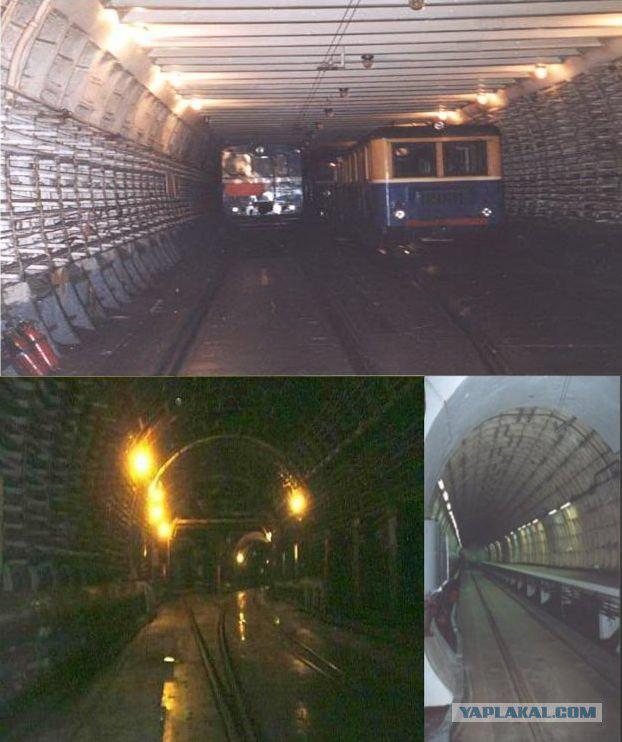
Near Moscow does have a network of secret tunnels and underground bunkers. Almost certainly connected underground between a complex of government buildings in the Butcher, the Old Town Square, the Kremlin, on Vozdvizhenka and Smolenskaya Square.
This is indicated by the leading "nowhere" ladder transitions to "Arbat", "Kiev" the radial & quot ;, a number of other subway stations deep location in the city center. (It should be noted that the unused staircases to "Tretyakov-2" - a reserve for the future transition to the second "Novokuznetskaya").
During the German air raids in 1941, bomb destroyed the ceiling of the tunnel Filevskaya line. This was one of the reasons for the construction of deep foundations backup site Pokrovskaya line in the 50s. Probably, but then began construction of special deep foundation line linking the complex Ramenki, bunkers under the building of the General Staff and the Ministry of Defence buildings in the downtown area.
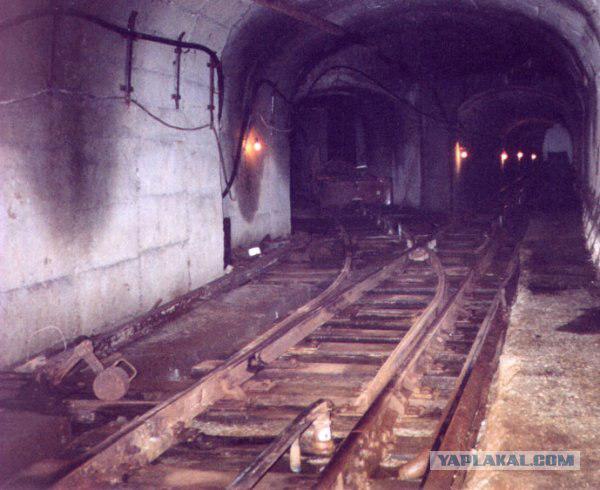
The line starts near the Kremlin / Arbat Square, stretches to the southwest parallel to the Sokolniki line past the campus of the General Staff on Frunze Embankment in Luzhniki.
Then the line goes under the bottom of the Moscow River and is connected with tunnels Sokolniki line through a tunnel, seen from the train, next of "sport" to "university", the left side of the direction of travel. Officially, it's working a dead end, but it goes further down between the major tunnels under the river and along the arc steeply to one side. Tunnel rests on the steel lattice gates, covered with fiberglass. Behind them are germovorota D28 with massive concrete blocks.

Private deep line from the center of Moscow in Ramenky needed because portions of Sokolniki line, from "Frunze" to "KGB" - shallow and, as Luzhniki Metro Bridge will be destroyed and will not be used in the event of a nuclear attack.
Spetsliniya seems, was built simultaneously with the extension of the line from Sokolniki "Culture Park" to "university." In the original draft, instead of the station "Sport" was two stations "Usachevsky" and "Luzhniki" at the entrance to the stadium. Instead, the bridge was supposed to tunnel under the Moscow River.
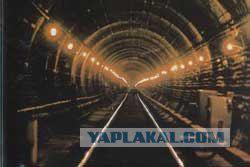
The project was hastily revised, bridges and tunnels were built at the same time. The bridge to the Sokolniki line, most likely, was chosen not only for reasons of low cost and construction time, but also because of relief, because the Sparrow Hills rise above the river is nearly 100 meters and the station "University" is almost a continuous rise. Perhaps there is an intermediate station on spetslinii near the station "University».
Carefully guarded kiosk ventilyatsinnoy mine of D6.
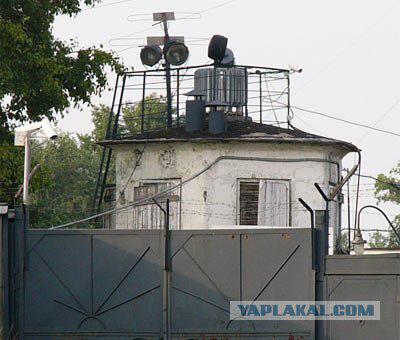
After complex Ramenki, the line continues on the southwest, by the Academy of the General Staff complex. This is evidenced by the presence of an interesting object on the highway Vostryakovsky administered by GUSP. The area is fenced with a large letter "M" on the gate :-) and sign "Main Directorate of the USSR Ministry of Railways subways. Laboratory tests and measurements of the Moscow subway. "

Until recently, the rolling stock used in rechargeable electric contact-Series "L", railcars Ezh6.
There are cars:
5580 - 5584, 5590 series Wagon cm3
Contact-5686 battery electric "L» 81-711.
Contact-5710 battery electric "L» 81-711.
Contact-5712 battery electric "L» 81-711.
Contact-0087 battery electric "L» 81-711.
Contact-0088 battery electric "L» 81-711.
Contact-0089 battery electric "L» 81-711.
0090 Wagon series Ezh6 81-712.
0091 Wagon series Ezh6 81-712.
0092 Wagon series Ezh6 81-712.
0093 Wagon series Ezh6 81-712.
DPS-01-1 - DPS-01-4 - diesel plant subway Lyudinovskiy four biaxial wagons.

Wagon Ezh6
Operating conditions require the presence in each car cockpit control and at the same time possible output / input through the front of the cab. Mass-produced cars 81-717 / 714 did not have a front door to the cockpit. Thus was launched the party wagons with bodies, like cars cm3, discontinued in 1978, but with a more modern electrical equipment.
In summer 1999, the composition of A and №0089 Ezh6 №0090-0091 are overhauled in Mytishchi. The picture shows the car Ezh6 to grapple with electric locomotive "L" At the same time electric "L" number 0088 has been converted into a diesel-electric locomotive with the ability to work and on the CD. Installed diesel plant "Zvezda" (St. Petersburg), the neutralization of the exhaust system and a removable roof. Completely replaced the interior cabs and the engine room.

The biggest myth - that logins are hidden almost at every station of the usual office doors, but this much is contrary to common sense and logic behind the creators of the secret network that, on the contrary, are too afraid "accidental" sightings.
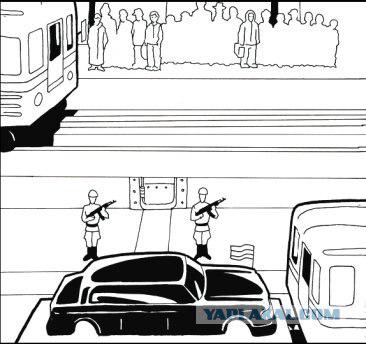
The line was started in the mid-1950s, although the idea was under Stalin, who had his own "spetsmetro '(narrow-gauge railway from the Kremlin to the near cottages in Matveyevskoye). It allows for easy transport communications facilities Defense Ministry.
In 1950 there was a temporary tunnel connecting the metro and the first subway line 2. Subsequently, the tunnel was closed because there was a new connection in the vicinity of the station Sport during the second phase of construction of the underground-2 under Khrushchev.
The main part was built in 1967, length together with all offshoots of about 27 km.
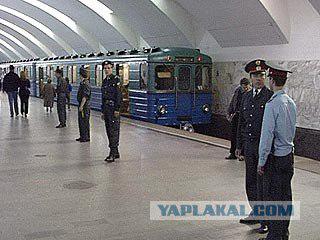
Line 2 (The system of "Transinzhstroy»)
An extensive two-tier transportation system being constructed of "Transinzhstroy."
Construction was started in the 80s. It is run by the SSO (Service of special facilities) GUSP. It connects the Kremlin and the FSB building in Lubyanka with the system of sensitive sites in the center of Moscow (among which are the North and South building), bunkers under Ivanovo hill, now serving the construction of Civil Defense Ministry of Interior of Russia under Zhitnaya Str., A new bunker southwest of Sermon and underground city in Ramenki. It is taking place at a depth of 130-190 meters.
Shafts on Obrucheva in Kanatchikovo, at Serpukhov, CHA, now serving Krivokolennyi, Podkopaevsky, Ulan and Arkhangelsk lanes are directly related to the system. view of the number 732 in the shaft alley
Krivokolennyi According to unconfirmed reports, in Ramenki sboyki completed construction of a system of D-6 and C-059 tunnel.
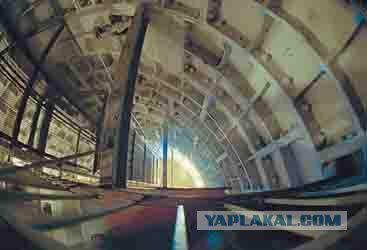
The system of the Council of Ministers
The line was built in the mid 70s. It begins at the House of the Russian Government (Council of Ministers building). Next comes partly under the Kutuzovsky Avenue, crossing the Kiev railway station, where one of the silos of communication. There is a popular belief about the existence of the station under the hotel "Ukraine". The line continues to go through along the Berezhkovskaya guest houses FSO and Mosfilm streets to block Ramenskoye underground complex located at Spetsavtobaza FSO in / h 95006 GUSP.
In a bunker you can go to Line 1 and 2. It is possible, the line goes on to the Research Institute "Voskhod" (FSUE SRI "Sunrise") on the street. Udaltsov, has been developing the system commissioned by the Council of Ministers.
"... More than thirty years ago, the Research Institute of Automatic Equipment (SRI AA), occupy the leading position in the application of computer technology, has received the state order from the Administrative Department of the Council of Ministers of the USSR to develop a system of economic management both in peacetime and in times of crisis ... < br /> ... The Institute was created and implemented a number of large automated systems were ordered by the Central Committee, the Military-Industrial Commission of the USSR Council of Ministers, the Ministry of Defence of the USSR, the KGB, the Soviet Foreign Ministry, Border Troops of the USSR and a number of other ministries and departments. The significance and scale of the first government orders showed great confidence in the staff of the Institute and of the tremendous responsibility that rested on his shoulders ... »

Zarevskaya system
Contrary to popular opinion, which says that between the FSB building in Lubyanka and air defense bunker in the Balashikha District of the Ministry of Defence of the tunnel exists, the system is abandoned and unfinished state (only reserve in the Balashikha District). Indeed, there is an object of "Transinzhstroy" Kuczynski in Forest Park, but mine complex there was never deployed, and many previously engaged in the construction of this spetstonnelya SMU-13 Metrostroi. There are some chatty oral testimony of former soldiers, who unanimously declared "neglect" of the object and impassable rubble on the roads, but it would be for something to dig into it, since there is further elementary impasse, hence the construction started, but not finished. But since this information is not possible to ensure that the interests of all close the topic community has recognized this trend also failed and the existing level of myth.
There are unconfirmed reports that the construction of the station Novokosino linked with the reconstruction / construction of facilities Zarёvskoy system.
"... When in place south of the village huts were Reutovo Krutitsy and Novokosino something was not already in the midst of the wasteland air ducts were mine tunnel ...»

Chekhov system
Contrary to many rumors, no tunnel connection with Moscow is not, although it was zapalnirovano. Indeed, in the village Alachkovo and Zakharkovo has production bases of "Transinzhstroy" and, indeed, for a few agglomerate settlements Chekhov (including Vaulovo) there are bunkers, some of them joined the approach roadways. Communication network of bunkers with Moscow Chekhov planned and, it is true, the master plan has been prepared, however, the construction of this line spetstonneley was carried out in the 80s and was interrupted in the 90th. Currently, some work is being done, but not with the intensity that had taken place earlier in the other authorities and other defense tasks.
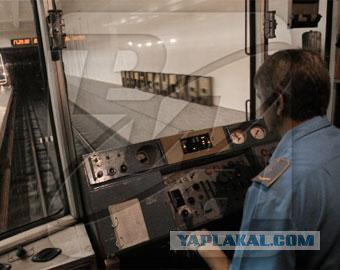
Other line.
Perhaps there are existing or under construction tunnels, or are separate systems, or the development of a system of "Transinzhstroy." It is assumed that there is a tunnel that connects the Odintsovo and Krasnoznamensk. It was also reported on the system service facilities at the Exhibition of Economic Achievements. Some employees of the GRU argue that building their agencies on Polezhaevskaya underground road tunnel connects the building of the Ministry of Defence on the Arbat.
It remains obscure the true purpose of building sites (owned by OAO "Transinzhstroy", according to the signboards) on Barricadnaya, Novoryazanskaya Street. Krylatskoye, at ENEA, the Taganka, Odintsovo.
This information is continuously interested in the security services of other stran.Dazhe was rip it out is such a card:

Now a system of tunnels and bunkers engaged in "service special facilities." Created Yeltsin's decree N350 of March 15, 1999 "SERVICE ISSUES IN SPECIAL FACILITIES PRESIDENT OF THE RUSSIAN FEDERATION."
The decree has interesting phrase:
& quot; ... the maintenance and operation in peacetime technical means of special facilities, special vehicles, as well as reliable operation in wartime and in peacetime emergency ... & quot;
& quot; ... includes ready special vehicles ... & quot;
This service is included in the General Directorate of Special Programs of the President of the Russian Federation (GUSP), its control is a huge sector: classified bunkers, tunnels and buildings across the country. Everything connected with the activities of GUSP murky. The head of the secret services never publicly accountable, as opposed to, for example, the director of the FSB !!!
That's the story of all Comrades I finished ...
Although not the subject of the infinite ...

Source:
Someone knows about it, so probably all heard.
I will try once again to their interpretation.
Material from many sources + own knowledge, so no links.
So: Since the beginning of the 90s, there were rumors about the existence of secret subway. Allegedly, three or four branches leading from the Kremlin to the military installations in Moscow (Podolsk Chekhov Vnukovo-2). When the Americans dropped the atomic bomb on Moscow, the government will be able to evacuate to a safe place.
According to some sources, this system is called
Metro-2, on the other - D-6.
20 ph and many letters

Location of sensitive sites in Moscow - a state secret. Until now, for example, footage of the annual aerial surveys of the capital in sealed packets sent to preview the headquarters of the Moscow Military District, and their storage is carried out subject to the expanded list of information to be classified according to the system of the Federal Service for Geodesy and Cartography of Russia.
This card is made of sensitive sites on the basis of public documents of the Moscow authorities, and therefore can not be complete. But even in this truncated form clearly shows the enormous area in the city center occupied by the security services.
On the map we have noted only unclassified intelligence services facilities - the headquarters, hospitals, hotels, etc. But there is among them a special list - the so-called "objects of subway construction Transinzhstroy," the former management of 10-A. The map clearly shows that not all of these objects are the same as the conventional scheme of the Moscow subway ...

1. FSB - st. B. Lubyanka, 1/2, Reception FSB - Kuznetsky Most, 22, Ch. the building of the Moscow department of the FSB - B.Kiselny lane. d.13 / 15
2. The object of subway "Transinzhstroya" - Krivokolenny lane.
3. Object FAPSI - Myasnitskaya Str. D. 48, p.1.
4. The building FAPSI - Sakharov avenue
5. Department of the Moscow department of the FSB in the North-East SA - ul. October 28, MOPNIEI and STC "Atlas" FAPSI - st. Obraztsova, 38,
6. Dep. Moscow Department of the Federal Security Service Center. And South East SA - Potapov lane. 7 subway construction object "Transinzhstroya" - Potapov lane. ow. 2/8
7. FSO GUSP - Kremlin
8. The Security Council and the CIS Antiterrorist Center - Str. Ilinka, FTPS - Maroseyka 12
9. The object of subway "Transinzhstroya" - st. Pottery, ow. 22-25
10. The object of subway "Transinzhstroya" - between Podkolokolny and Paul Lane., Clinic FSB - Trehsvyatitelsky M. per., 4, page 2
11. The object of subway "Transinzhstroya" - 2nd Kadashevsky lane. Tolmachevsky per., 5-7
12. The object of subway "Transinzhstroya" - st. B.Serpuhovskaya ow. 26
13. The object of subway "Transinzhstroya" - Maronovsky lane.
14. Press service of the Foreign Intelligence Service - st. Ostozhenka 51/10.
15. Object FAPSI (referred Shilov Gallery) - st. Znamenka, 3 p.1., State Technical Commission - st. Znamenka, 19.
16. Ministry of Defence - a complex of buildings on the Arbat
17. NTC "Atlas" FAPSI - st. M.Gruzinskaya, 3, p.4
18. The object of subway "Transinzhstroya" - Barrikadnaya, 8
19. Hotel FSB - the hotel "Beijing", 5th floor
20. The object of subway "Transinzhstroya" - Dmitrovsky per., 5-7
Metro-2 - the total informal name of the existing network of secret underground communications for special purposes in Moscow.
Official information about the network location of its lines and stations available. The Russian government officially neither confirm nor deny its existence. Also, there are no published pictures, videos, and any other evidence of the existence of the network. The sources devoted to this subject, the system is usually called "Metro-2».
The site also mentions the alleged official name "D-6", but in reality it is only the name of the fixed Line 1.
However, various sources (partial list See below.) Argue that the system is in Moscow exists, connects Moscow Kremlin and other government agencies with government and military silos (many of which are allegedly in the far suburbs) and serves primarily to evacuate and messages in the event of nuclear war.

There are many rumors and speculations about the existence of the secret of Moscow subway lines. This topic has been widely discussed in the press in the early 90s. It has been many versions, sometimes the most fantastic and unbelievable.
The strategic importance of the system of underground tunnels is enormous. Not surprisingly, since the beginning of the construction of stations and tunnels carrying not only transport but also voenno-defensive function. In the construction of the second phase of the subway station was a "Soviet" located under the Soviet area, between the stations "Theater" (in those days, "Sverdlov Square") and "Mayakovskaya". In order to accelerate the construction of the station was never built (more about the projects, see the second stage. The history section projects). Using elements of the original design of the plant was built for the highly protected underground bunker command post of the Moscow headquarters of GO. Tunnels are a few dozen meters from the bunker.

Near Moscow does have a network of secret tunnels and underground bunkers. Almost certainly connected underground between a complex of government buildings in the Butcher, the Old Town Square, the Kremlin, on Vozdvizhenka and Smolenskaya Square.
This is indicated by the leading "nowhere" ladder transitions to "Arbat", "Kiev" the radial & quot ;, a number of other subway stations deep location in the city center. (It should be noted that the unused staircases to "Tretyakov-2" - a reserve for the future transition to the second "Novokuznetskaya").
During the German air raids in 1941, bomb destroyed the ceiling of the tunnel Filevskaya line. This was one of the reasons for the construction of deep foundations backup site Pokrovskaya line in the 50s. Probably, but then began construction of special deep foundation line linking the complex Ramenki, bunkers under the building of the General Staff and the Ministry of Defence buildings in the downtown area.

The line starts near the Kremlin / Arbat Square, stretches to the southwest parallel to the Sokolniki line past the campus of the General Staff on Frunze Embankment in Luzhniki.
Then the line goes under the bottom of the Moscow River and is connected with tunnels Sokolniki line through a tunnel, seen from the train, next of "sport" to "university", the left side of the direction of travel. Officially, it's working a dead end, but it goes further down between the major tunnels under the river and along the arc steeply to one side. Tunnel rests on the steel lattice gates, covered with fiberglass. Behind them are germovorota D28 with massive concrete blocks.

Private deep line from the center of Moscow in Ramenky needed because portions of Sokolniki line, from "Frunze" to "KGB" - shallow and, as Luzhniki Metro Bridge will be destroyed and will not be used in the event of a nuclear attack.
Spetsliniya seems, was built simultaneously with the extension of the line from Sokolniki "Culture Park" to "university." In the original draft, instead of the station "Sport" was two stations "Usachevsky" and "Luzhniki" at the entrance to the stadium. Instead, the bridge was supposed to tunnel under the Moscow River.

The project was hastily revised, bridges and tunnels were built at the same time. The bridge to the Sokolniki line, most likely, was chosen not only for reasons of low cost and construction time, but also because of relief, because the Sparrow Hills rise above the river is nearly 100 meters and the station "University" is almost a continuous rise. Perhaps there is an intermediate station on spetslinii near the station "University».
Carefully guarded kiosk ventilyatsinnoy mine of D6.

After complex Ramenki, the line continues on the southwest, by the Academy of the General Staff complex. This is evidenced by the presence of an interesting object on the highway Vostryakovsky administered by GUSP. The area is fenced with a large letter "M" on the gate :-) and sign "Main Directorate of the USSR Ministry of Railways subways. Laboratory tests and measurements of the Moscow subway. "

Until recently, the rolling stock used in rechargeable electric contact-Series "L", railcars Ezh6.
There are cars:
5580 - 5584, 5590 series Wagon cm3
Contact-5686 battery electric "L» 81-711.
Contact-5710 battery electric "L» 81-711.
Contact-5712 battery electric "L» 81-711.
Contact-0087 battery electric "L» 81-711.
Contact-0088 battery electric "L» 81-711.
Contact-0089 battery electric "L» 81-711.
0090 Wagon series Ezh6 81-712.
0091 Wagon series Ezh6 81-712.
0092 Wagon series Ezh6 81-712.
0093 Wagon series Ezh6 81-712.
DPS-01-1 - DPS-01-4 - diesel plant subway Lyudinovskiy four biaxial wagons.

Wagon Ezh6
Operating conditions require the presence in each car cockpit control and at the same time possible output / input through the front of the cab. Mass-produced cars 81-717 / 714 did not have a front door to the cockpit. Thus was launched the party wagons with bodies, like cars cm3, discontinued in 1978, but with a more modern electrical equipment.
In summer 1999, the composition of A and №0089 Ezh6 №0090-0091 are overhauled in Mytishchi. The picture shows the car Ezh6 to grapple with electric locomotive "L" At the same time electric "L" number 0088 has been converted into a diesel-electric locomotive with the ability to work and on the CD. Installed diesel plant "Zvezda" (St. Petersburg), the neutralization of the exhaust system and a removable roof. Completely replaced the interior cabs and the engine room.

The biggest myth - that logins are hidden almost at every station of the usual office doors, but this much is contrary to common sense and logic behind the creators of the secret network that, on the contrary, are too afraid "accidental" sightings.

The line was started in the mid-1950s, although the idea was under Stalin, who had his own "spetsmetro '(narrow-gauge railway from the Kremlin to the near cottages in Matveyevskoye). It allows for easy transport communications facilities Defense Ministry.
In 1950 there was a temporary tunnel connecting the metro and the first subway line 2. Subsequently, the tunnel was closed because there was a new connection in the vicinity of the station Sport during the second phase of construction of the underground-2 under Khrushchev.
The main part was built in 1967, length together with all offshoots of about 27 km.

Line 2 (The system of "Transinzhstroy»)
An extensive two-tier transportation system being constructed of "Transinzhstroy."
Construction was started in the 80s. It is run by the SSO (Service of special facilities) GUSP. It connects the Kremlin and the FSB building in Lubyanka with the system of sensitive sites in the center of Moscow (among which are the North and South building), bunkers under Ivanovo hill, now serving the construction of Civil Defense Ministry of Interior of Russia under Zhitnaya Str., A new bunker southwest of Sermon and underground city in Ramenki. It is taking place at a depth of 130-190 meters.
Shafts on Obrucheva in Kanatchikovo, at Serpukhov, CHA, now serving Krivokolennyi, Podkopaevsky, Ulan and Arkhangelsk lanes are directly related to the system. view of the number 732 in the shaft alley
Krivokolennyi According to unconfirmed reports, in Ramenki sboyki completed construction of a system of D-6 and C-059 tunnel.

The system of the Council of Ministers
The line was built in the mid 70s. It begins at the House of the Russian Government (Council of Ministers building). Next comes partly under the Kutuzovsky Avenue, crossing the Kiev railway station, where one of the silos of communication. There is a popular belief about the existence of the station under the hotel "Ukraine". The line continues to go through along the Berezhkovskaya guest houses FSO and Mosfilm streets to block Ramenskoye underground complex located at Spetsavtobaza FSO in / h 95006 GUSP.
In a bunker you can go to Line 1 and 2. It is possible, the line goes on to the Research Institute "Voskhod" (FSUE SRI "Sunrise") on the street. Udaltsov, has been developing the system commissioned by the Council of Ministers.
"... More than thirty years ago, the Research Institute of Automatic Equipment (SRI AA), occupy the leading position in the application of computer technology, has received the state order from the Administrative Department of the Council of Ministers of the USSR to develop a system of economic management both in peacetime and in times of crisis ... < br /> ... The Institute was created and implemented a number of large automated systems were ordered by the Central Committee, the Military-Industrial Commission of the USSR Council of Ministers, the Ministry of Defence of the USSR, the KGB, the Soviet Foreign Ministry, Border Troops of the USSR and a number of other ministries and departments. The significance and scale of the first government orders showed great confidence in the staff of the Institute and of the tremendous responsibility that rested on his shoulders ... »

Zarevskaya system
Contrary to popular opinion, which says that between the FSB building in Lubyanka and air defense bunker in the Balashikha District of the Ministry of Defence of the tunnel exists, the system is abandoned and unfinished state (only reserve in the Balashikha District). Indeed, there is an object of "Transinzhstroy" Kuczynski in Forest Park, but mine complex there was never deployed, and many previously engaged in the construction of this spetstonnelya SMU-13 Metrostroi. There are some chatty oral testimony of former soldiers, who unanimously declared "neglect" of the object and impassable rubble on the roads, but it would be for something to dig into it, since there is further elementary impasse, hence the construction started, but not finished. But since this information is not possible to ensure that the interests of all close the topic community has recognized this trend also failed and the existing level of myth.
There are unconfirmed reports that the construction of the station Novokosino linked with the reconstruction / construction of facilities Zarёvskoy system.
"... When in place south of the village huts were Reutovo Krutitsy and Novokosino something was not already in the midst of the wasteland air ducts were mine tunnel ...»

Chekhov system
Contrary to many rumors, no tunnel connection with Moscow is not, although it was zapalnirovano. Indeed, in the village Alachkovo and Zakharkovo has production bases of "Transinzhstroy" and, indeed, for a few agglomerate settlements Chekhov (including Vaulovo) there are bunkers, some of them joined the approach roadways. Communication network of bunkers with Moscow Chekhov planned and, it is true, the master plan has been prepared, however, the construction of this line spetstonneley was carried out in the 80s and was interrupted in the 90th. Currently, some work is being done, but not with the intensity that had taken place earlier in the other authorities and other defense tasks.

Other line.
Perhaps there are existing or under construction tunnels, or are separate systems, or the development of a system of "Transinzhstroy." It is assumed that there is a tunnel that connects the Odintsovo and Krasnoznamensk. It was also reported on the system service facilities at the Exhibition of Economic Achievements. Some employees of the GRU argue that building their agencies on Polezhaevskaya underground road tunnel connects the building of the Ministry of Defence on the Arbat.
It remains obscure the true purpose of building sites (owned by OAO "Transinzhstroy", according to the signboards) on Barricadnaya, Novoryazanskaya Street. Krylatskoye, at ENEA, the Taganka, Odintsovo.
This information is continuously interested in the security services of other stran.Dazhe was rip it out is such a card:

Now a system of tunnels and bunkers engaged in "service special facilities." Created Yeltsin's decree N350 of March 15, 1999 "SERVICE ISSUES IN SPECIAL FACILITIES PRESIDENT OF THE RUSSIAN FEDERATION."
The decree has interesting phrase:
& quot; ... the maintenance and operation in peacetime technical means of special facilities, special vehicles, as well as reliable operation in wartime and in peacetime emergency ... & quot;
& quot; ... includes ready special vehicles ... & quot;
This service is included in the General Directorate of Special Programs of the President of the Russian Federation (GUSP), its control is a huge sector: classified bunkers, tunnels and buildings across the country. Everything connected with the activities of GUSP murky. The head of the secret services never publicly accountable, as opposed to, for example, the director of the FSB !!!
That's the story of all Comrades I finished ...
Although not the subject of the infinite ...

Source:
